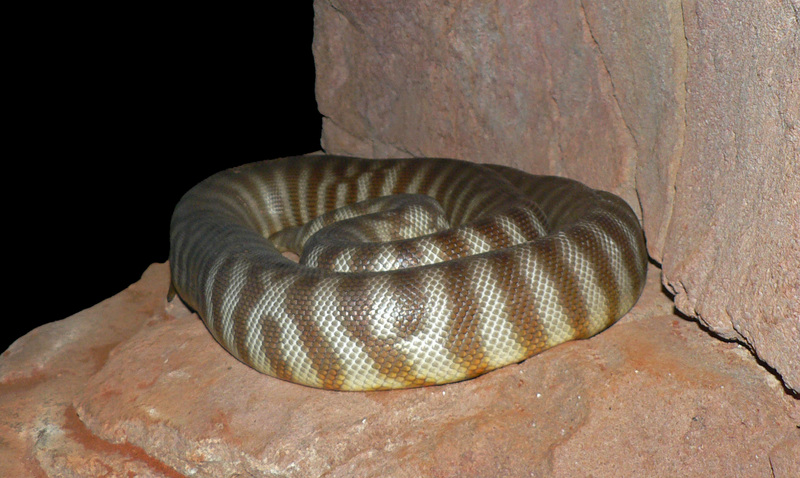|
| Query: woma python | Result: 2nd of 6 | |
Woma Python (Aspidites ramsayi) - Wiki
| Subject: | Woma Python (Aspidites ramsayi) - Wiki
| |

| Resolution: 1668x996
File Size: 535042 Bytes
Date: 2007:01:13 18:52:52
Camera: DMC-FZ5 (Panasonic)
F number: f/2.8
Exposure: 10/600 sec
Focal Length: 60/10
Upload Date: 2007:10:16 13:58:44
|
ERROR : Server Busy(-1105)
ERROR : Server Busy(-1105)
Woma Python (Aspidites ramsayi) - Wiki
Aspidites ramsayi
From Wikipedia, the free encyclopedia
[Photo] Woma Python (Aspidites ramsayi) at Sydney Wildlife World. Date 13 January 2007. Photo credit: Peter Halasz (http://en.wikipedia.org/wiki/User:Pengo). Source: http://en.wikipedia.org/wiki/Image:Woma_01_Pengo.jpg
Common names: woma, woma python, Ramsay's python.
Aspidites ramsayi is a non-venomous python species found in Australia. No subspecies are currently recognized.
Description
Adults average 1.5 m (4.5 feet) in length. The head is narrow and the eyes small. The body is broad and flattish in profile while the tail tapers to a thin point. The scales are small and smooth and in appearance. The dorsal scales are smooth with 50-65 rows at midbody, 280-315 ventral scales, an undivided anal plate and 40-45 mostly single subcaudal scales. Some of the posterior subcaudals may be irregularly divided.
The color pattern consists of a ground color that varies from medium brown and olive to lighter shades of orange, pink and red, overlaid with a striped or brindled pattern. The belly is cream or light yellow with brown and pink blotches. The scales around the eyes are usually a darker colour than the rest of the head.
Geographic range
Found in Australia in the west and center of the country: from Western Australia through southern Northern Territory and northern South Australia to southern Queensland and northwestern New South Wales. Its range may be discontinuous. The type locality given is "near Forte Bourke" [New South Wales, Australia].
Conservation status
This species is classified as Endangered (EN) on the IUCN Red List of Threatened Species with the following criteria: A1c (v2.3, 1994). A species is listed as such when the best available evidence indicates that a population reduction of at least 50% has occurred over the last 10 years or three generations, whichever is the longer, based on a decline in area of occupancy, extent of occurrence and/or quality of habitat. It is therefore considered to be facing a very high risk of extinction in the wild. Year assessed: 1996.
The Adelaide Zoo in South Australia is co-ordinating a captive breeding program for the species, and the offspring raised are being released back into the Arid Recovery Reserve near Roxby Downs in the states north.
Behavior
Largely nocturnal. By day this snake may be found sheltering in hollow logs or under leaf debris.
Feeding
These snakes feed mostly by raiding nests of rodents. They enter a nest and use their bodies to crush their prey against the walls of the burrow. This technique often results in scarring as it is not always successful in quickly killing the prey.
Reproduction
Oviparous with 5-20 eggs per clutch. Females remain coiled around their eggs until they hatch, with the incubation period lasting 2-3 months.
Captivity
Considered very docile and easily to handle, it is a highly sought after exotic pet. Although it is considered to be an endangered species, largely due to shrinking territory, this snake can be bred in captivity.
http://en.wikipedia.org/wiki/Aspidites_ramsayi
| The text in this page is based on the copyrighted Wikipedia article shown in above URL. It is used under the GNU Free Documentation License. You may redistribute it, verbatim or modified, providing that you comply with the terms of the GFDL. |
|
Comments |
|---|
| | Guest |
|
Scientific Name: Aspidites ramsayi (Macleay, 1882)
Common Names:
English – Ramsay's Python, Woma
French – Python De Ramsay
Spanish – Pitón De Ramsay
Synonyms: Aspidiotes ramsayi Macleay, 1882 |
^o^
Animal Pictures Archive for smart phones
^o^
|
|
|

